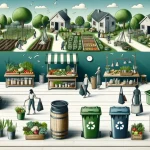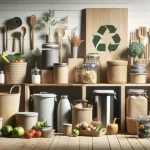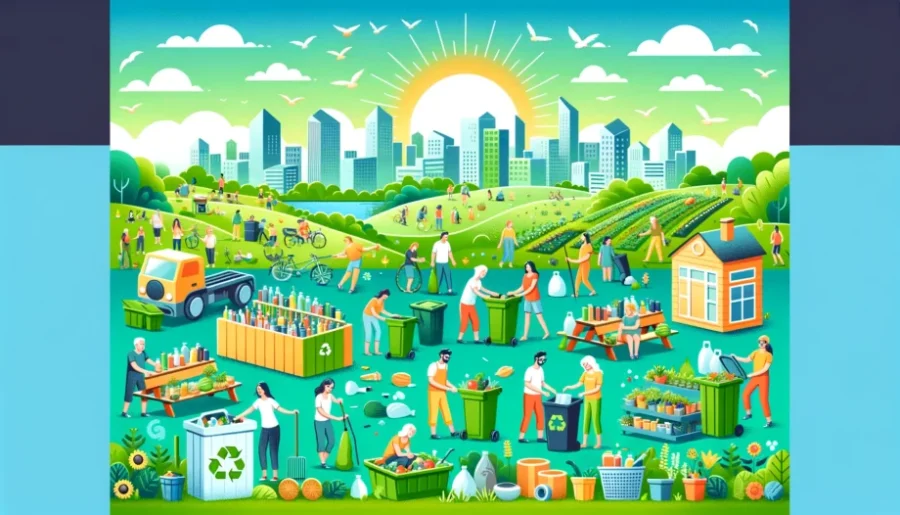
Hey, eco-friend! Get ready to uncover zero-waste and why It matters. This isn’t just about ditching plastic straws; it’s a full-on lifestyle shift that’s good for your wallet, health, and our beautiful planet.
Key Takeaways:
- Zero-Waste and Why It Matters emphasizes:
- Reducing waste to its absolute minimum, focusing on reusing, recycling, and composting.
- This approach is crucial for conserving resources, reducing pollution, and combating climate change.
- Adopting zero-waste practices can lead to a healthier planet and sustainable living for all.
Zero-Waste and Why It Matters for Our Planet and Future
Are you ready to dive into the world of zero-waste living? It’s not just a trend; it’s a lifestyle about slashing the trash and giving our planet a much-needed breather.
From cutting down on food waste to ditching those pesky plastic bags, zero-waste living is about making smart, sustainable choices.
And guess what? It’s easier than you think! So, let’s roll up our sleeves, get creative, and explore how going zero-waste can make a huge difference for our environment and our future.
Are you in? Let’s get this green party started!
The Climate Crisis and Zero-Waste: A Critical Connection
The climate crisis is like a ticking time bomb, and every little action we take can either defuse it or make it explode.
Enter zero-waste living, a superhero in the fight against global warming.
By adopting a zero-waste lifestyle, we’re not just saying no to unnecessary waste; we’re also giving a big thumbs up to reducing greenhouse gas emissions.
Zero waste
Zero waste, or waste minimization, is a set of principles focused on waste prevention that encourages redesigning resource life cycles so that all products are repurposed (i.e. “up-cycled”) and/or reused. The goal of the movement is to avoid sending trash to landfills, incinerators, oceans, or any other part of the environment. Currently 9% of global plastic is recycled.[1] In a zero waste system, all materials are reused until the optimum level of consumption is reached. Wikipedia
How Zero-Waste Lifestyle Contributes to Reducing Greenhouse Gas Emissions
Think about it – every time we recycle, we’re preventing items from ending up in landfills where they release methane, a potent greenhouse gas.
Recycling between 2020 and 2050 is expected to cut emissions by a whopping 5.5 to 6.02 gigatons of carbon dioxide, which is like taking over a billion cars off the streets for a year.
And it’s not just about recycling; by refusing, reducing, and reusing, we’re cutting down on the energy needed to produce new products from scratch.
For example, recycling aluminum saves 95% of the energy required to make new cans from raw materials.
The Role of Zero Waste in Mitigating Global Warming
Zero waste isn’t just about managing waste; it’s about rethinking the way we live.
It’s about choosing products with less packaging, supporting businesses that prioritize sustainability, and finding creative ways to reuse what we already have.
For instance, composting turns our food scraps into nutrient-rich soil, reducing the need for chemical fertilizers and helping to sequester carbon in the ground.
By embracing zero waste, we’re not only reducing our individual carbon footprints but also inspiring others to do the same.
It’s a ripple effect that can lead to significant changes in how we produce, consume, and dispose of goods.
Together, we can create a more sustainable future and keep our planet cool, one reusable water bottle at a time.
So, are you ready to join the zero-waste movement and be a climate hero? Let’s roll up our sleeves and make a difference, one small step at a time!
Table 1: Zero Waste Principles
| Principle | Description |
|---|---|
| Refuse | Say no to unnecessary items and single-use products. |
| Reduce | Minimize the amount of waste you produce. |
| Reuse | Use items multiple times before disposing of them. |
| Recycle | Properly recycle items that can be processed into new products. |
| Rot (Compost) | Compost organic waste to return nutrients to the soil. |
Understanding the Environmental Impact of Our Waste
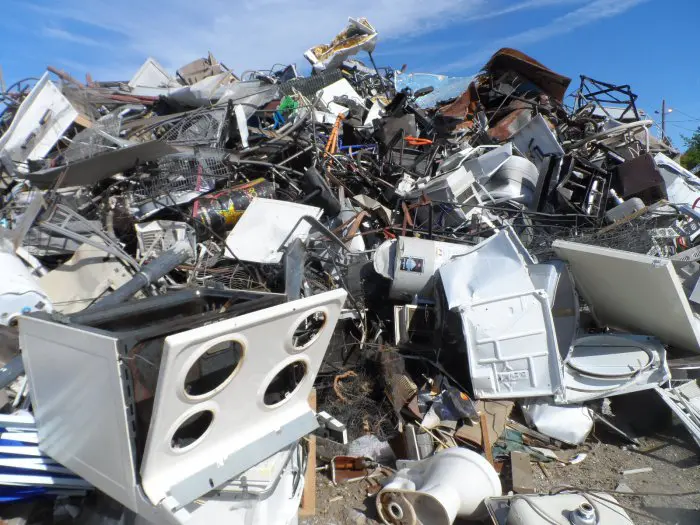
Our waste doesn’t just disappear. It leaves a hefty footprint on our planet, affecting natural resources and ecosystems in ways we might not even realize.
How the Amount of Waste Affects Natural Resources
Every item we toss in the trash has a backstory involving natural resources.
Take plastic, for example. About 400 million metric tons of plastic waste are produced each year, but only 9% gets recycled.
The rest? It ends up polluting our oceans or sitting in landfills, where it can take hundreds of years to break down.
And let’s not forget the resources used to make all that plastic in the first place, like oil and water.
It’s a cycle of waste that keeps taking from our planet without giving back.
The Detrimental Effects of Waste Generation on Ecosystems
Waste doesn’t just impact the land; it wreaks havoc on our marine life too.
Microplastics have been found in 100% of turtles, 59% of whales, 36% of seals, and 90% of seabirds studied.
Over 100,000 marine mammals are killed each year due to waste pollution.
On land, food waste is a major issue, with 54% occurring “upstream” during production and 46% “downstream” at the processing and consumption stages.
This waste contributes to climate change, water scarcity, and biodiversity loss.
In Europe, the issue of waste is closely linked to resource use. While resource extraction has remained stable, the continent’s dependence on imports is growing.
This not only raises questions about resource security but also shifts environmental problems to exporting countries.
The EU’s ambition is to decouple economic growth from environmental degradation, focusing on life-cycle thinking and sustainable waste management to reduce impacts.
It’s clear that our waste has far-reaching consequences on the environment.
By understanding these impacts, we can make more informed choices about how we produce, consume, and dispose of goods, moving towards a more sustainable future.
The Zero Waste Movement: Pioneering a Sustainable Future
History and Evolution of the Zero Waste Movement
The roots of the zero waste movement trace back to the 1970s, with chemist Paul Palmer’s Zero Waste Systems aimed at reducing chemical waste in laboratories.
The movement gained momentum in the 1990s, with an emphasis on recycling. Notably, Warren Snow in New Zealand and Daniel Knapp’s Urban Ore in Berkeley, California, played pivotal roles in advancing zero waste principles.
By the early 2000s, cities like San Francisco set ambitious zero-waste goals, further propelling the movement into the mainstream.
Key Principles and Goals
- Refuse, Reduce, Reuse, Recycle, and Rot (5 Rs): These principles guide individuals and communities toward zero-waste living, emphasizing the importance of refusing unnecessary items, reducing consumption, reusing products, recycling materials, and composting organic waste.
- Circular Economy: The zero waste movement advocates for a shift from a linear to a circular economy, where products and materials are kept in use for as long as possible, and waste is minimized. This approach aims to create sustainable production and consumption patterns that conserve natural resources and reduce environmental impacts.
- Extended Producer Responsibility: A key goal is to hold producers accountable for the entire lifecycle of their products, encouraging them to design products that are easier to reuse, recycle, or compost, thereby reducing waste.
- Community Engagement: The movement emphasizes the role of communities in driving change, from participating in recycling programs to supporting zero-waste businesses and policies.
- Sustainable Resource Management: Zero waste principles promote the sustainable management of resources, aiming to protect ecosystems and ensure the long-term availability of natural resources.
Read more about extending zero-waste principles and practices
The Future of Zero Waste
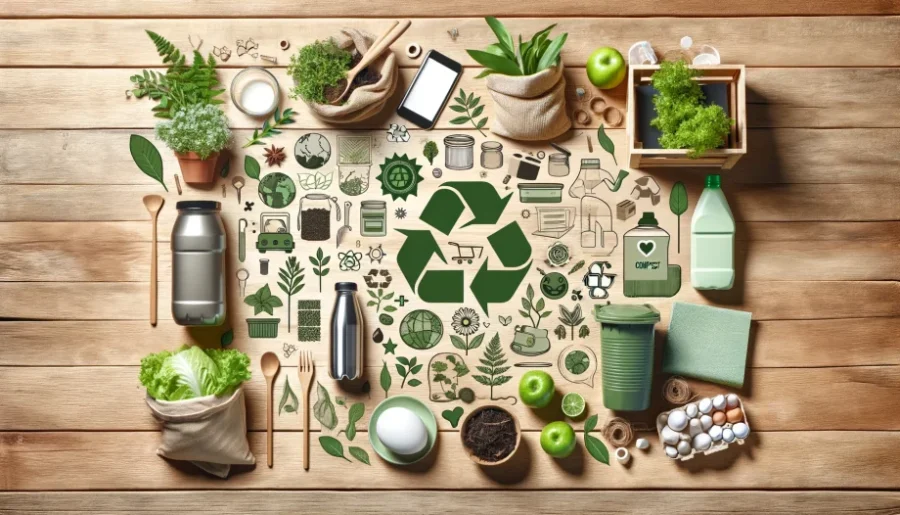
The zero-waste movement continues to evolve, with an increasing focus on addressing plastic pollution, promoting compostable packaging, and integrating zero-waste practices into business models.
The movement’s success relies on collaboration between individuals, businesses, and governments, as well as a collective commitment to rethinking our relationship with waste.
As awareness grows, the zero waste movement has the potential to drive significant environmental and social change, paving the way for a more sustainable and equitable future.
Tackling Food Waste: A Vital Aspect of Zero-Waste Living
The Significance of Reducing Food Waste in Zero-Waste Practices
Reducing food waste is a crucial component of zero-waste living. Not only does it address global hunger by redirecting food to those in need, but it also has significant environmental benefits.
Approximately one-third of all food produced globally goes uneaten, leading to unnecessary greenhouse gas emissions, water usage, and land exploitation.
By reducing food waste, we can alleviate pressure on natural resources and reduce the environmental impact of food production.
Strategies for Managing Food Scraps and Organic Waste Effectively
- Smart Shopping and Meal Planning: Plan your meals and shop accordingly to avoid buying more than you need. This helps reduce the amount of food that goes to waste in households.
- Proper Storage: Store food correctly to extend its shelf life. This includes understanding how different foods should be stored and the significance of use-by and best-before dates.
- Composting: Composting food scraps is a great way to recycle nutrients back into the soil. It reduces the amount of waste sent to landfills and provides a rich, natural fertilizer for gardens.
- Community Involvement: Participate in or support local food rescue programs and community composting initiatives. These programs help redistribute surplus food and manage organic waste effectively.
- Education and Awareness: Raise awareness about the impact of food waste and the importance of waste reduction. Encourage others to adopt sustainable practices and share tips on how to reduce food waste.
By implementing these strategies, we can make significant strides toward reducing food waste and promoting a more sustainable, zero-waste lifestyle.
Reducing Plastic Waste: A Focus on Single-Use Items
The Problem with Plastic Bags and Single-Use Plastic in Waste Streams

Plastic waste, particularly from single-use items like plastic bags, is a major environmental issue.
Every year, approximately 8 million tons of plastic waste escape into the oceans, harming marine life and ecosystems.
Plastics can take hundreds of years to break down, and during this time, they can entangle and kill marine animals, enter the food chain, and even impact human health.
The majority of ocean plastic pollution comes from countries lacking proper waste management infrastructure.
Alternatives and Solutions for Minimizing Plastic Waste
To tackle the plastic waste problem, we need to focus on reducing our reliance on single-use plastics and improving waste management systems. Here are some alternatives and solutions:
- Ban Single-Use Plastics: Implementing bans on single-use plastic items like bags, straws, and cutlery can significantly reduce plastic waste. Countries like India and regions like the European Union have taken steps to limit or ban single-use plastics.
- Promote Reusable Alternatives: Encourage the use of reusable bags, containers, and utensils to reduce the demand for single-use plastics. Providing incentives for using reusable items can help shift consumer behavior.
- Improve Recycling Infrastructure: Enhance recycling facilities and processes to ensure more plastics are recycled and less end up in landfills or the environment. Educating the public about proper recycling practices is also crucial.
- Support Circular Economy Models: Transitioning to a circular economy, where products are designed for reuse, repair, and recycling, can help maintain the value of materials and reduce waste. This approach includes designing products for longevity and recyclability and promoting business models that prioritize sustainability.
- Increase Public Awareness: Raising awareness about the impacts of plastic pollution and the importance of reducing plastic use can motivate individuals and communities to adopt more sustainable practices.
By implementing these strategies, we can make significant progress in reducing plastic waste and protecting our environment from the harmful effects of plastic pollution.
Embracing the Circular Economy: A Path to Zero Waste
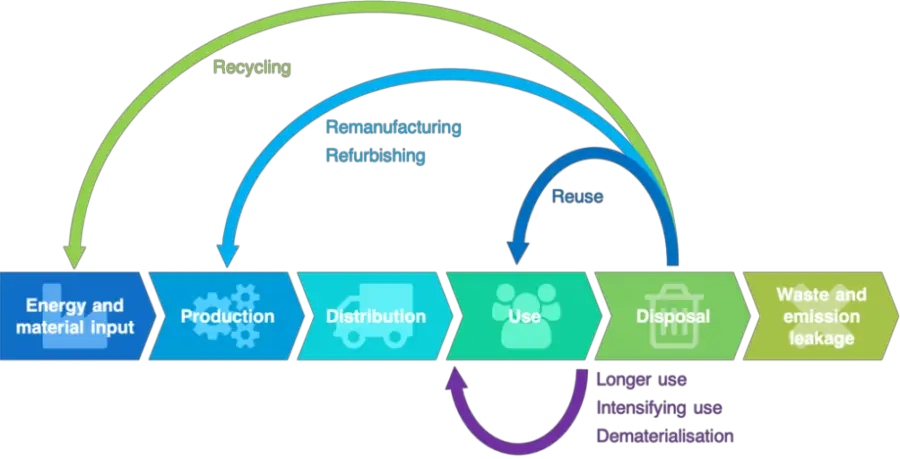
In a world grappling with waste and environmental degradation, the circular economy emerges as a beacon of sustainability.
It’s a radical shift from the traditional linear economy, offering a pathway to a future where waste is designed out, resources are endlessly cycled, and natural systems are regenerated.
Let’s dive into how this visionary concept intertwines with zero-waste principles, driving us toward a more sustainable, resilient, and prosperous world.
Explaining the Concept of a Circular Economy
Circular economy
A circular economy (also referred to as circularity or CE) is a model of resource production and consumption in any economy that involves sharing, leasing, reusing, repairing, refurbishing, and recycling existing materials and products for as long as possible. The concept aims to tackle global challenges such as climate change, biodiversity loss, waste, and pollution by emphasizing the design-based implementation of the three base principles of the model. Wikipedia
The circular economy is a sustainable alternative to the traditional linear economy.
It minimizes waste and maximizes resource efficiency by keeping materials, products, and resources in circulation for as long as possible.
This approach is restorative and regenerative by design, aiming to preserve natural capital, optimize resource yields, and minimize system risks.
The Connection to Zero Waste
- Complementary Goals: Zero waste and the circular economy share a common goal of eliminating waste. While zero waste focuses on keeping waste out of the environment, the circular economy goes further by aiming to regenerate the environment.
- Systematic Approach: The circular economy provides a framework for achieving zero waste, offering strategies for designing out waste, keeping products in use, and regenerating natural systems.
Rethinking Product Design and Resource Use
- Sustainable Design: Products are designed for durability, repairability, and recyclability, ensuring they can be used and reused for as long as possible.
- Optimized Resources: The circular economy prioritizes the use of renewable resources and reduces reliance on finite materials, creating a more sustainable system.
Incorporating Circular Principles into Daily Life
- Conscious Choices: Individuals can contribute by reducing consumption, reusing products, and recycling or composting waste.
- Business Innovation: Companies can adopt circular practices by designing products with their entire lifecycle in mind and finding ways to repurpose materials.
The circular economy represents a transformative approach to sustainability, aligning closely with zero-waste principles.
By rethinking how we design, use, and dispose of products, we can pave the way for a future that is not only waste-free but also regenerative and prosperous.
The Benefits of Zero Waste: Beyond Environmental Impact
The zero-waste approach is more than an environmental strategy; it’s a holistic philosophy that enhances human health, strengthens economies, and preserves our planet’s resources.
Let’s explore the multifaceted benefits of zero waste and how it’s reshaping our world for the better.
Advantages for Human Health and Economies
- Healthier Communities: Zero waste practices, such as reducing the use of toxic materials and promoting clean air and water, lead to healthier communities. By minimizing exposure to pollutants, zero waste contributes to improved public health outcomes.
- Economic Growth: Zero waste initiatives stimulate economic growth by creating jobs in recycling, composting, and sustainable product design. They also encourage innovation in the circular economy, leading to new business opportunities and markets.
- Cost Savings: Municipalities and businesses that adopt zero waste strategies often experience cost savings through reduced waste management expenses, lower disposal fees, and increased efficiency in resource use.
Positive Impacts on Greenhouse Gases and Resource Conservation
- Reduced Greenhouse Gas Emissions: Zero waste practices, such as composting organic waste and recycling materials, significantly reduce greenhouse gas emissions. By diverting waste from landfills, zero waste helps mitigate climate change.
- Conservation of All Resources: Zero waste emphasizes the conservation of all resources by promoting the reuse, repair, and recycling of products. This approach reduces the demand for new raw materials, conserving natural resources and preserving biodiversity.
Table 2: Benefits of Zero Waste
| Benefit | Description |
|---|---|
| Environmental Impact | Reduces pollution and conserves natural resources. |
| Economic Growth | Creates jobs in recycling and sustainable product design. |
| Health and Well-being | Reduces exposure to toxins and promotes cleaner communities. |
| Social Equity | Supports fair and inclusive resource distribution. |
By embracing zero waste, we’re not only protecting our environment but also fostering healthier communities, driving economic growth, and conserving precious resources.
Zero waste is a pathway to a more sustainable and equitable future, where the health of people and the planet are prioritized.
Zero Waste at Home: Small Changes with Big Impact
Adopting a zero-waste lifestyle at home doesn’t have to be overwhelming.
With small, manageable changes, you can significantly reduce your environmental footprint and contribute to a more sustainable future.
Let’s explore some practical tips for getting started and the importance of embracing reusable products.
Practical Tips for Adopting a Zero-Waste Lifestyle
- Start with a Waste Audit: Assess the types of waste you generate at home to identify areas for improvement.
- Reduce Single-Use Items: Swap out disposable items like plastic bags, water bottles, and coffee cups for reusable alternatives.
- Compost Kitchen Scraps: Set up a compost bin to turn food scraps into nutrient-rich soil for your garden.
- Buy in Bulk: Purchase food and household items in bulk to reduce packaging waste.
- DIY Household Products: Make your own cleaning and personal care products to avoid unnecessary packaging and harmful chemicals.
The Importance of Reusable Products and Reducing Excess Consumption
- Cost Savings: Reusable products often save money in the long run by reducing the need for frequent repurchases.
- Resource Conservation: By choosing reusable items, you help conserve natural resources and reduce the demand for raw materials.
- Less Waste: Embracing reusables directly contributes to less waste ending up in landfills and the environment.
Table 3: Zero Waste at Home
| Change | Impact |
|---|---|
| Use cloth bags | Reduces plastic waste from single-use bags. |
| Buy in bulk | Minimizes packaging waste. |
| Compost food scraps | Reduces landfill waste and creates nutrient-rich soil. |
| Use reusable bottles | Decreases the number of disposable plastic bottles used. |
| Repair and repurpose | Extends the life of items and reduces the need for new goods. |
Zero waste at home is about making conscious choices and embracing small changes that collectively lead to a big impact.
By adopting a zero-waste mindset and incorporating reusable products into your daily routine, you can play a vital role in protecting our planet for future generations.
Zero Waste and Policy: The Role of Government and Organizations
Government bodies and organizations play a crucial role in promoting and implementing zero-waste initiatives.
Through policies, regulations, and support programs, they can provide the framework and resources needed for communities and businesses to adopt zero-waste practices.
Let’s explore how entities like the Zero Waste International Alliance (ZWIA) and environmental protection agencies contribute to this movement and the impact of their efforts.
Contributions of ZWIA and Environmental Protection Agencies
- ZWIA: The Zero Waste International Alliance develops and promotes zero-waste principles and standards globally. It offers guidance and support to communities and organizations striving for zero waste, fostering a network of advocates and practitioners.
- Environmental Protection Agencies: These government agencies are responsible for regulating and enforcing environmental laws. They often provide resources, funding, and technical assistance for waste reduction programs and support research and education on sustainable waste management.
Impact of Policies and Regulations
- Setting Targets: Many governments have set ambitious zero-waste targets and goals, providing a clear direction for waste reduction efforts.
- Regulating Waste Management: Policies and regulations can mandate recycling, composting, and waste diversion practices, reducing the amount of waste sent to landfills.
- Incentivizing Sustainable Practices: Governments can offer incentives such as tax breaks, grants, and subsidies to encourage businesses and individuals to adopt zero-waste practices.
- Encouraging Product Stewardship: Policies can require manufacturers to take responsibility for the entire lifecycle of their products, including end-of-life management, promoting a more circular approach to production.
Table 4: Zero Waste Policy Actions
| Policy Action | Description |
|---|---|
| Implement bans | Prohibit single-use plastics and other non-recyclable materials. |
| Set waste reduction targets | Establish goals for reducing waste generation and increasing recycling rates. |
| Provide incentives | Offer financial or other benefits for businesses and individuals who reduce waste. |
| Support education and outreach | Raise awareness about zero waste practices and their benefits. |
The collaboration between governments, organizations, and communities is essential for the widespread adoption of zero-waste practices. By implementing supportive policies and fostering a culture of sustainability, we can make significant strides towards a zero-waste future.
Looking Ahead: Zero Waste for Future Generations
The journey toward zero waste is not just about addressing today’s waste management challenges; it’s about securing a sustainable and healthy planet for future generations.
The long-term vision of zero waste encompasses a world where resources are valued and conserved, and environmental impacts are minimized.
Let’s explore how this vision can benefit our planet and why collective action is crucial for making a significant impact on the climate crisis.
The Long-Term Vision of Zero Waste
- Sustainable Resource Management: A zero-waste future involves the sustainable management of resources, where materials are reused and recycled, reducing the need for new raw materials and conserving natural habitats.
- Reduced Environmental Pollution: By minimizing waste generation and diverting waste from landfills, zero waste practices help reduce air, water, and soil pollution, contributing to a cleaner and healthier environment.
- Enhanced Biodiversity: Conserving resources and reducing pollution supports biodiversity, ensuring that ecosystems remain resilient and continue to provide essential services.
Encouraging Collective Action
- Community Engagement: Communities play a vital role in zero waste initiatives. Grassroots movements, local organizations, and individuals can drive change through education, advocacy, and participation in waste reduction programs.
- Collaboration Across Sectors: Achieving zero waste requires collaboration between governments, businesses, non-profits, and the public. By working together, stakeholders can develop and implement effective strategies for waste reduction and resource conservation.
- Global Cooperation: Addressing the climate crisis and achieving zero waste on a global scale necessitates international cooperation. Shared goals and collaborative efforts can lead to innovative solutions and the widespread adoption of zero-waste practices.
Looking ahead, the vision of zero waste offers a blueprint for a more sustainable and equitable world.
By embracing zero waste principles and encouraging collective action, we can protect our planet for future generations and make meaningful progress in the fight against the climate crisis.
FAQs: Navigating Zero-Waste Living
The zero-waste journey can be both exciting and challenging. Here are some common questions and answers to help you navigate the path to a more sustainable lifestyle.
Q. What exactly is zero waste?
A. Zero waste is a philosophy and approach that aims to eliminate waste by reducing, reusing, recycling, and composting.
The goal is to prevent waste from ending up in landfills, incinerators, or the environment, thereby conserving resources and protecting the planet.
Q. How can I start living a zero-waste lifestyle?
A. Start small by focusing on one area of your life, such as your kitchen or bathroom.
Identify items you can replace with reusable alternatives, such as swapping single-use plastic bags for cloth bags.
Gradually incorporate more zero-waste practices into your daily routine, and remember that progress is more important than perfection.
Q. What are some common challenges of zero-waste living?
A. Some challenges include finding affordable and accessible zero-waste alternatives, overcoming convenience habits, and dealing with social pressures.
It’s important to be patient and persistent and to seek support from the zero-waste community when needed.
Q. How can I reduce waste when shopping?
A. Bring your own reusable bags, containers, and produce bags when shopping.
Choose products with minimal or no packaging, and consider buying in bulk to reduce packaging waste.
Opt for items made from sustainable and recyclable materials.
Q. Can zero waste save me money?
A. Yes, zero waste can lead to cost savings in the long run. By investing in reusable items, you’ll reduce the need for disposable products.
Additionally, buying in bulk and choosing sustainable options can lower your overall expenses.
Q. How does zero waste benefit the environment?
A. Zero waste practices help reduce pollution, conserve natural resources, and minimize greenhouse gas emissions.
By diverting waste from landfills and reducing the demand for new materials, zero waste contributes to a healthier and more sustainable planet.
Embracing zero waste is a journey that requires commitment, creativity, and a willingness to learn and adapt.
By taking small steps and making conscious choices, you can make a positive impact on the environment and lead a more sustainable lifestyle.
Zero-Waste and Why It Matters: Conclusion
In this blog, we talked about why zero-waste matters. Zero-waste is important for keeping our world healthy and sustainable.
It’s about reducing waste, using resources wisely, and caring for our planet.
Time for Action
- Individual Efforts: Start with simple changes at home. Use reusable products, compost, and think about what you buy.
- Community Leadership: If you can lead, push for changes in your community that support zero-waste.
Spreading Awareness
- Educate Others: Share what you know about zero waste with others.
- Inspire Action: Encourage people to join the zero-waste movement by showing them how easy and beneficial it can be.
The Future of Zero Waste
- A Collective Commitment: Let’s all commit to zero waste and work together for a cleaner, greener world.
- A Sustainable Step Forward: Every small step counts. Let’s embrace zero waste and move towards a sustainable future.
By following zero-waste principles, we can help our planet, save resources, and make a better future for everyone. Let’s commit to zero waste and take a step toward a more sustainable future.
Read more: Mastering Zero-Waste Living: 7 Easy Tips and Tricks
Zero-Waste: Resources
Here are some valuable resources to help you dive deeper into zero-waste living, connect with organizations, and find tools for reducing waste:
Further Reading
- “Zero Waste Home” by Bea Johnson: A guide to simplifying your life by reducing waste.
- Zero Waste Home is available on Amazon
- “101 Ways to Go Zero Waste” by Kathryn Kellogg: Practical tips for reducing waste in everyday life.
-
- 101 Ways to Go Zero Waste is available on Amazon
Zero Waste Organizations
- Zero Waste International Alliance (ZWIA): An organization promoting zero waste principles and standards globally.
- Zero Waste Europe: An organization working to create a zero-waste future in Europe.
Tools for Reducing Waste
- Eco-Cycle’s Zero Waste Tools: Resources for individuals, businesses, and communities to reduce waste.
- Terracycle’s Zero Waste Box: A program that allows you to recycle items that are typically non-recyclable.
United Nations and Government Sites
- United Nations Environment Programme – Waste Management: Information and resources on sustainable waste management practices.
- U.S. Environmental Protection Agency – Sustainable Materials Management: Resources and tools for reducing waste and improving material management.
By exploring these resources, you can gain more knowledge about zero-waste living, connect with like-minded individuals and organizations, and find practical tools to help you reduce waste in your daily life.




